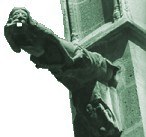
Gothic Design
Learn More.
| HOME Feature Articles Stone Carver's Tour Virtual Cathedral Cathedral Tours Gothic Field Guide GOTHIC GEOMETRY Virtual Abbey Medieval Art Tours Castle Tours Links Resources About The Site FAQ |
|
Gargoyles! Etymology
n. gar·goyle [gär-"goil] Middle English gargoyl,
from Middle French gargouille; akin to Middle French gargouiller
and from the same root word from which we derive gurgle, gullet,
gully, gulp, gurgitation. Date: 13th Definition
The
gargoyle often makes his perch -
Oliver Herford
Evolution
By
the 12th century, however, the venerable St. Bernard of Clairvaux
was ranting against the origins of the weird and irreverent carvings
in his cloister. This was at a moment of time when The
Catholic Church was now entrenched throughout the known world:
"What are these fantastic monsters doing in the cloisters under the very eyes of the brothers as they read? What is the meaning of these unclean monkeys, strange savage lions and monsters? To what purpose are here placed these creatures, half beast, half man? St. Bernard, the grand master of organization who established the austere Cisterian order, was a stickler for dogma : What did monsters have to do with Christ dying for our sins? Why did stonecarvers continue to insist on this bizarre decoration? In his diatribe he finally posed the eternal question of administers everywhere: ...and what are they costing me? A century later, gargoyles finally became the natural progeny of the grotesques St. Bernard railed against. Not only did they not go away, but those pagan grotesques were now serving as a primitive form of machinery: hollowed out then lined with lead, they were dubbed 'gargoyles' for the noise made as they violently spit rain water away from ledges and outcroppings. The
Last Gargoyle Washington National Cathedral, completed in the late 20th century, have featured them; and the Cathedral of St. John the Divine in New York which has yet to be completed. There's hope for yet another revival. Until then, gargoyles and grotesques (wherever they have managed to survive) continue to fire our imaginations as they watch over us in cities throughout the world. As it turns out, it may be our turn to watch over them. |
Sponsored
Links
copyright © 2017
 century.
century.